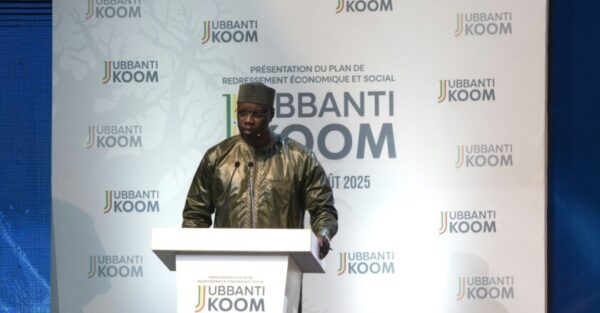Announced on August 1st from the Grand Théâtre de Dakar in a meticulously staged setting, the Economic and Social Recovery Plan “Jubbanti Koom” emerges as the founding act of the economic doctrine of the Diomaye-Sonko government. Designed for the decade, anchored in the presidential Vision 2050, this program aims to lift Senegal out of dependence and short-term management through strategic, rigorous, and assertive planning.
The context allows for no naivety. Fifteen months after an unprecedented and conflictual change in power, the State inherits a deteriorated situation: persistent twin deficits, public debt estimated at nearly 77% of GDP (even higher if off-balance sheet commitments are included), massive arrears, and an administrative apparatus corroded by clientelism. In this constrained setting, “Jubbanti Koom” is as much a truth operation as a manifesto of sovereignty.
A plan that is both quantified and symbolic
Estimated at 5,667 billion CFA francs over the period 2025-2029, the plan displays a rare transparency in budgeting, line by line, to restore the country’s financial credibility. A clear message to donors, whose trust has eroded since the suspension of the IMF program. One of the markers of this desire for a break is the revival of the National Public Debt Committee, dormant for years: a promise of control, both technical and political.
Between pragmatic Keynesianism and assertive sovereignty
In substance, the plan oscillates between moderate interventionism (state investment in infrastructure, agriculture, human capital) and methodical sovereignty. The pillars – food, energy, land, and even monetary autonomy – evoke a return to post-independence developmental strategies, but without nostalgia or romanticism. This is a rational sovereignty, inscribed in a planned sequence of three stages: recovery, impulse, acceleration.
The parallel is drawn with the major African attempts at economic planning – from the Senegalese Four-Year Plan (1961-1964) to Uganda’s Obote II Plan in the 1980s. Where these experiences failed due to lack of consistency or institutional capacity, “Jubbanti Koom” presents itself as an attempt at hybridization: budgetary discipline, mobilization of internal resources, state reform, industrial targeting, and integration into global value chains.
A strategic detour through China
The recent visit of the Prime Minister to China illustrates this quest for a model. Between Confucianism, Maoist vestiges, and digitized state capitalism, Sonko seems to have perceived a coherence where Africa struggles to articulate memory, pragmatism, and vision. This ideological dimension of the plan reinforces its scope: “What Africa lacks,” he will say, “is not genius, but architecture.”
But history will judge by execution
This is where the real test lies. Senegal, like many post-colonial states, has often planned but rarely implemented. The execution of the plan will be confronted with resistant institutions, an impatient society, and limited resources. The bet on autonomy, without margin for error, requires high-level public engineering.
The Prime Minister stated: “We expect nothing from the IMF. What we present today is based solely on the Senegalese people.” This almost Gaullist determination is accompanied by strong measures: creation of an inter-ministerial task force attached to the Prime Minister’s Office, direct involvement of technocrats, and refocusing of public action on clearly identified social objectives (free healthcare, youth employment, housing, education).
But the numbers raise questions.
1. 90% internal financing: an ambition on the brink of unrealism.
The plan aims to finance 7,127 billion CFA francs out of 7,919 billion through internal resources. However, the tax pressure rate remains low (16.8% of GDP in 2023), well below the UEMOA norm (20%). Budgetary margins are narrow, rigidities numerous (wage bill, debt service), and debt high. Mobilizing on this scale would require an administrative and fiscal revolution in a few months. Unlikely without adjusting the timeline or external support, even partially.
2. Will the new revenues (gas, land, online betting) suffice?
They are promising but uncertain. Gas revenues depend on the effective start of projects (Tortue, Sangomar), contractual conditions, and global prices. Land reform is slow and politically risky. As for online betting, it remains a niche. These resources alone will not cover the massive social promises of the plan.
3. State reduction and asset recycling: empty promise or real windfall?
The government is counting on reducing the size of the state and valorizing public assets to generate 5,677 billion in three years. This figure, higher than the current annual investment budget, arouses skepticism. Such operations are lengthy, politically sensitive, and can harm sovereignty if they involve strategic assets (energy, telecoms, land).
4. Restoring donors’ confidence: what roadmap?
In a post-IMF context, with unpaid domestic debts and dubious PPPs, several options are available:
– resumption of a technical program with the IMF (Staff-Monitored);
– audit and publication of domestic debt and concessions;
– strict application of the LOLF;
– transparency in extractive revenues (strengthened EITI);
– constructive dialogue with bilateral partners.
These signals are necessary to reassure markets and donors, while preserving the proclaimed strategic autonomy.
Conclusion: an African bet on Africa
“Jubbanti Koom” is both an economic program, a political manifesto, and an attempt to reinvent the State. Neither populist nor technocratic, the plan aims to embody a new African realism: sovereign, social, strategic. But between intention and impact, there is the reality of a state apparatus to reform, a productive fabric to rebuild, and a society to engage.
Senegal plays a tune here that goes against the grain of dominant doctrines. Provided it holds the note.


